Menu
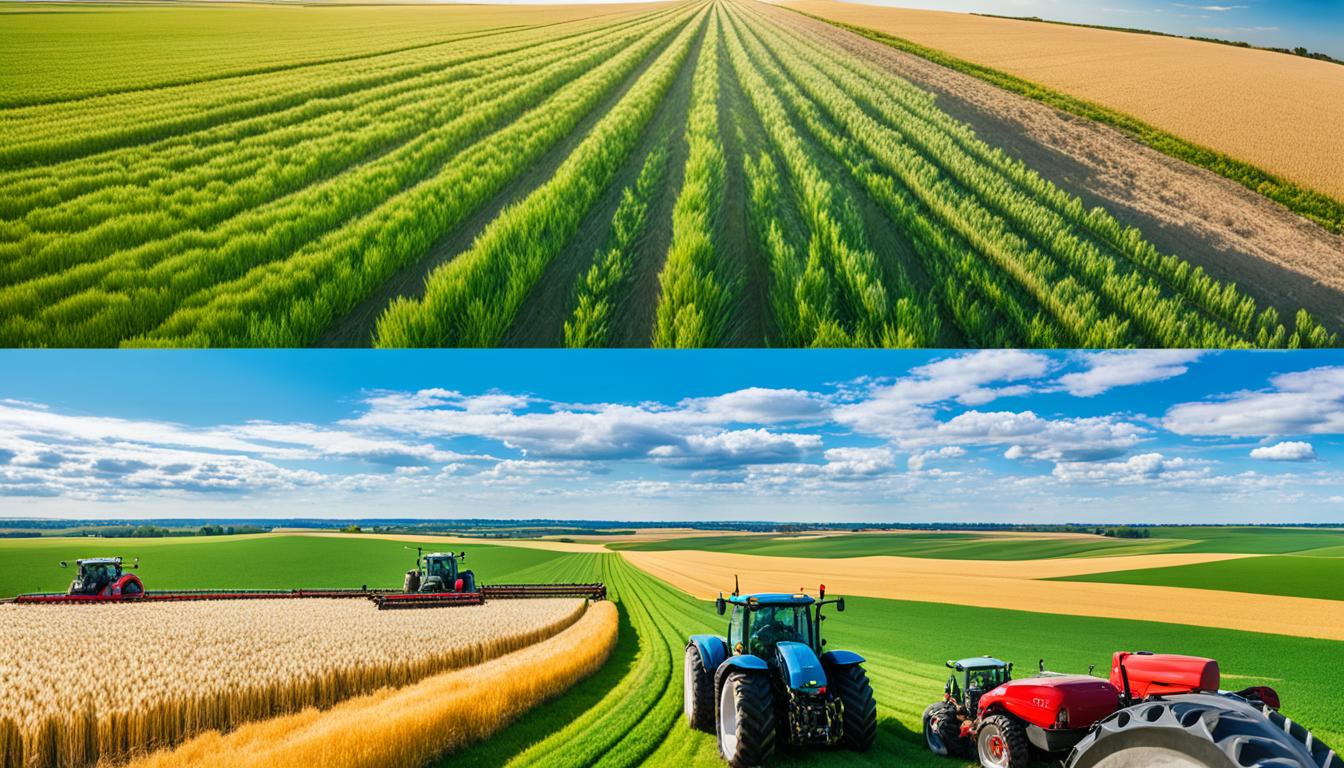
In February 2024, Ukraine set a new record during wartime. It shipped 5.2 million metric tons of grains and other farm products from Greater Odesa ports through the new Ukrainian corridor. This shows how hard Ukraine is working to rebuild its agriculture, despite facing huge losses of over $80 billion in the war.
The United States Department of Agriculture (USDA) increased its estimates for Ukraine’s grain and oilseed exports for the year 2023/24. By April, they upped their forecast by 7.3 million metric tons. This proves how important Ukraine’s grains are for the world, making up 10% of the global market before 2022.
Yet, Ukraine’s journey back is not easy. The halt of the Black Sea Grain Initiative by Russia forced a move to new shipping routes, like the Ukrainian corridor. These routes helped keep exports up, but most of the recent exports were late shipments, not new products.
Despite facing attacks and losing 19.5% of its farmland in the last two years, Ukraine’s agriculture is fighting back. The sector is using new approaches and pushing for investments to rebuild its position in the world. This effort is crucial for its future.
Ukraine has always been a major player in the grain farming world. It’s known as the ‘breadbasket of Europe’, thanks to its fertile lands. These lands help Ukraine produce lots of wheat, corn, and barley.
More than half of Ukraine’s land can be used for farming. This area supports the country’s main exports, which include grain.
In 2021, agriculture helped 14% of Ukraine’s people have jobs. It made up 41% of what Ukraine sold to other countries, making $27.8 billion. Ukraine is a big name in the global market, being the 6th top corn producer and the 4th biggest corn exporter. It’s the 7th largest wheat producer and the 5th largest wheat exporter.
These numbers show just how crucial grain farming is in Ukraine. It’s a key part of the country’s economy.
| Crop | Production (MT) | Global Production Rank | Exports (MT) | Global Export Rank |
|---|---|---|---|---|
| Corn | 41,900,000 | 6th | 23,000,000 | 4th |
| Wheat | 33,000,000 | 7th | 19,000,000 | 5th |
| Barley | 9,900,000 | 4th | 5,800,000 | 3rd |
The Russian attack has hurt Ukraine’s farming sector. Ukrainian farmers are working hard to recover from these damages. Their main challenges include rebuilding their systems and overcoming trade disruptions.
Issues with logistics and trade have made it hard to export as much grain as before. The sector urgently needs local and international support to fully recover.
The war has hit grain farming hard in Ukraine. It has messed up getting the crops to market. This has made it hard for Ukraine to meet global grain needs, dropping its agricultural GDP by 39% from last year.
The ongoing conflict means a lot less cropland is being used now. The USDA says we’ve seen a big drop in the area growing wheat, corn, and barley. This is due to the fighting and its effects on farming.
The fighting has greatly affected the ways grains can be shipped out. For years, Ukraine used the Black Sea for exports. Now, with that route less safe, other ways to move grains have become vital. But, making these new routes work has changed how much grain Ukraine can export:
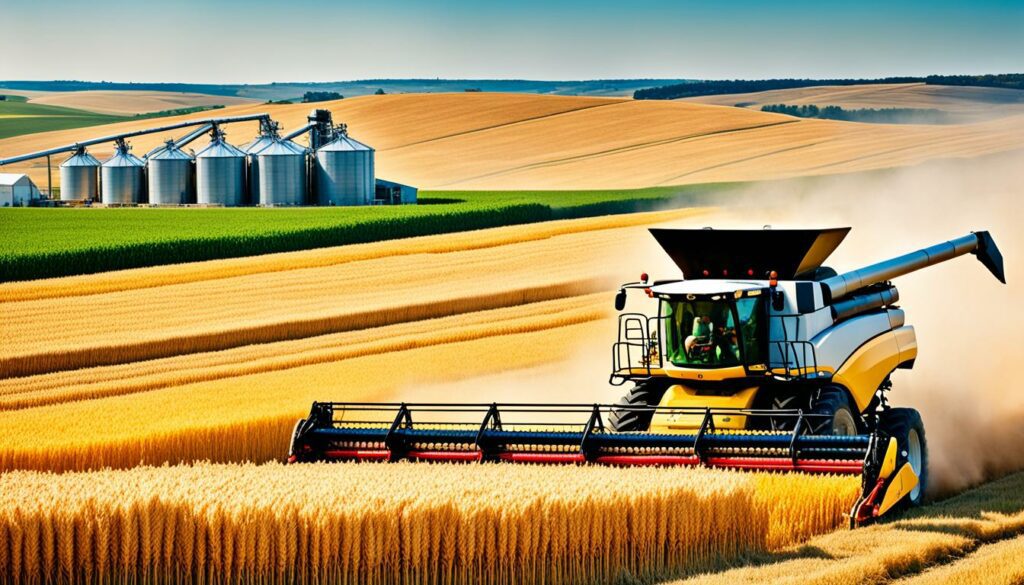
| Export Destination | Wheat Exports Pre-February 2022 | Wheat Exports Post-February 2022 | Corn Exports Pre-February 2022 | Corn Exports Post-February 2022 |
|---|---|---|---|---|
| Europe | Less than 2% | 50% | Less than 40% | Over 64% |
| Middle East and North Africa | 53% | 34% | Almost 25% | 17% |
| Sub-Saharan Africa | 10% | 3% | – | – |
| East Asia | Notable volumes | Marked decline | Notable volumes | Marked decline |
Land being taken over and attacks on farming areas have cut down on farming space. This has reduced grain production in Ukraine. Much of the farming land can’t be used, leading to big drops in the growing areas of wheat, corn, and barley:
This is hurting Ukraine’s farming and its ability to make money. The country faces tough times now and in the future because of the war. Stopping the fighting and rebuilding are crucial for the Ukrainian agriculture.
The agricultural sector in Ukraine has seen big challenges. To keep up, Ukrainian farmers are using new methods to boost their crops. This helps Ukraine stay strong in agriculture even during tough times.
Sustainable crop practices are getting more popular in Ukraine. Farmers are using methods that keep the land healthy for the long run. Things like crop rotation and not tilling the soil too much help crops grow better and don’t need as many chemicals.
These steps are in line with the world’s push to be more sustainable. With agriculture making up 41% of what Ukraine sells abroad, these practices are more important than ever. They are key to keeping the agriculture economy strong.
Another key part of farming in Ukraine is precision agriculture. This method uses satellite maps, GPS, and data to farm smarter. With this tech, farmers can water, fertilise, and protect their crops better. They use just what’s needed, which cuts down on waste and production costs.
Precision farming isn’t just about solving problems after war. It’s a smart way to farm. By farming this way, Ukraine can avoid nearly US$80 billion in crop damages by the end of 2023. It also helps save a lot of money, US$56.1 billion, by making farms more productive after being destroyed.
| Year | Wheat Production (million tonnes) | Maize Production (million tonnes) | Barley Production (million tonnes) |
|---|---|---|---|
| 2021 | 32 | 42 | 9.4 |
By using new and precise farming methods, Ukraine’s agriculture is changing. These innovations not only help farmers’ futures but also make Ukraine a strong player in global farming.
The agricultural policy Ukraine greatly helps grain farms with grants and easier processes. The World Bank has invested over $132 million to boost agriculture. This money comes under the Accelerating Private Investments in Agriculture Program for Results.
Many small greenhouses and orchards got these grants. It helps them stay strong against tough conditions. For example, Victoria’s Sense farm grew to 8.8 hectares with the support of the “Garden Grant”.
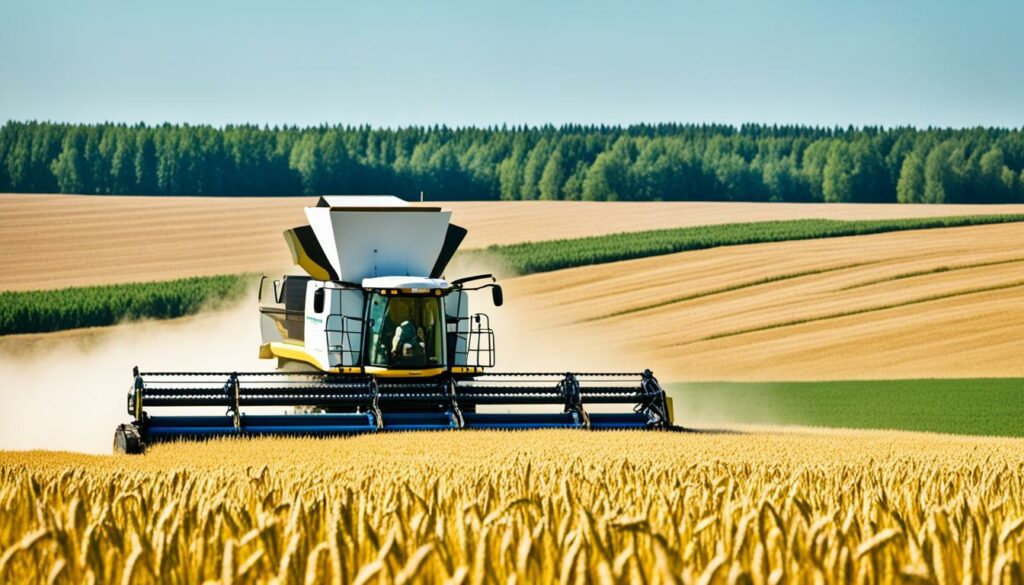
Going digital is a big move too. The Ministry of Agrarian Policy in Ukraine makes applying for grants easier with the “Diya” app. This helps farmers get money more easily, making government support agriculture wider.
The policy also aims to create jobs. To get a grant, farms must promise to make new jobs. This not only boosts the economy in the countryside but also helps communities when things get hard.
| Aspect | Details |
|---|---|
| World Bank Financing | $132 million |
| Grant Beneficiaries | 150+ greenhouses and orchards |
| Eligible Farms | Gardens up to 25 hectares |
| Supported Areas | 8.8 hectares (e.g., Victoria’s Sense farm) |
| Application Process | Digitised via “Diya” app |
| Job Creation Requirement | Mandatory for grant approval |
The agricultural policy Ukraine and government support agriculture are key in helping grain farms. They make the farm sector strong and able to face challenges.
International aid plays a big role in helping Ukraine’s farming, especially since the conflict there. The United States Agency for International Development (USAID) has been a key supporter. It’s helped Ukraine’s farming industry a lot through many projects.
The AGRI-Ukraine project is at the heart of USAID’s work. In its first year, this project got $100 million from USAID and $250 million from other places. This was a huge help, leading to a combined $350 million.
USAID plans to add $250 million more, aiming to also get a matching $250 million. This would mean a total investment of $500 million. So, the total USAID investment could reach $850 million.
Thanks to this support, Ukrainian farmers have received vital resources. Over 12,800 farmers got seeds, fertilisers, and pesticides. In a time of war, these items are essential for farming.
USAID’s support is clear in small farm operations. Small farms often face challenges due to lack of resources and not enough workers because of the conflict. By providing needed supplies, USAID has really helped these farms stay productive.
About 28% of Ukraine’s farming companies were able to sell their crops this year with USAID’s help. This was despite the conflict with Russia. USAID’s work has been key in keeping Ukraine’s food and farming strong.
USAID’s consistent effort highlights the huge role of international aid agriculture in Ukraine. Working with local groups like the Ministry of Agrarian Policy and Food, USAID shows long-term support for Ukrainian farming. They are focused on both rebuilding and improving Ukraine’s agriculture.
Agricultural tech has boomed in Ukraine, boosting the grain sector. This growth comes from using modern equipment and drones. This mix has lifted both efficiency and output, despite the ongoing conflict.
The conflict pushed Ukrainian farmers to turn to high-tech machinery. This move aimed to up productivity. Advanced equipment, like tractors with GPS and automated harvesters, is key. They optimize work, slash costs, and lessen losses.
Ukraine’s adoption of seed drills and irrigation systems also plays a big part. They keep crops healthy. This is vital for meeting food needs at home and abroad.
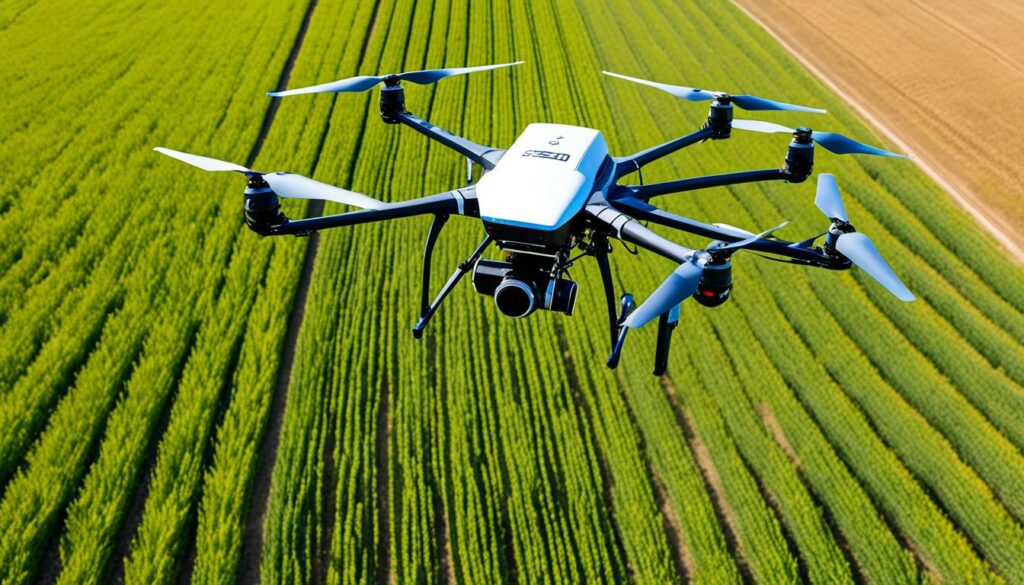
Drones are making a big difference in Ukrainian agriculture. They give instant data on crops, soil, and resources. This allows for exact use of fertilizers and pesticides. Plus, it cuts down on waste.
Drones also watch over vast areas more efficiently. This helps manage crops better and lowers costs. They’re crucial for modern farming in Ukraine. They ensure farmers produce enough food to meet global needs.
These tech improvements are vital as Ukraine works towards being more food secure. Global hunger has been on the rise. It went up from 8.4% to 9.9% between 2019 and 2020.
I met several amazing Ukrainian farmers during my travels. Their hard work and new ideas led to big Ukrainian farming achievements. Even in a tough year filled with conflict, they kept on farming. This helped keep food flowing both locally and globally.
A special story was about 20 farmers who went from Ukraine to Algona, Iowa. They wanted to learn about better farming methods, especially getting fertiliser. They brought back new ideas and a strong will to face their homeland’s challenges.
The war hasn’t stopped these farmers. They kept working, despite the risks of unexploded bombs. They even used an old Russian tank for farming. This smart move let them work in dangerous fields, showing the power of thinking creatively in hard times.
The United States has been a big help to them. Ukrainian farmers are thankful for the U.S.’s efforts in keeping peace and supporting their farming. With this help, they produced 278,000 more tonnes of grain in the last growing season.
“We rely on continued support from the United States, not just for survival, but for our well-being and prosperity,” emphasised one of the visiting farmers.
There are many successful farming stories in Ukraine. They show strong will and community. For example, women played a big part, with 28% of supported farms led by them. Their role is key during these difficult times.
This year, they produced 278,000 more tonnes of grain. This brought in over $127.8 million. With support and new ways, Ukrainian farming achievements will keep growing. They are truly inspiring the world of agriculture.
The story of grain farming in Ukraine is changing. After years of war, the country aims to use new tech and green methods. This is key to farming’s future, making it both productive and good for the environment.
In February 2024, Ukraine set a big goal. It shipped 5.2 million metric tons of grains and oilseeds. The USDA thinks Ukraine will do even better this year. They’ve upped their estimate by 7.3 million metric tons.
In the past, Ukraine did well too. It sent out 67.52 million metric tons in 2018 and 74.09 million in 2020. But, this year, there might be some problems. The USDA predicts less wheat, corn, and barley fields.
Despite these issues, Ukraine doesn’t stop. It keeps growing, using new ways and being strong. This shows in its farming numbers.
Being green is now a top aim for Ukraine’s farmers. They want to do farming that lasts, without hurting the Earth. Big projects, like the AGRI-Ukraine programme, are helping a lot. The USA and other friends have put in $350 million to change how farming works. This is on top of another $250 million they’ve added.
Improving how they send out grains can help a lot. Ukraine thinks it can send out 2.5 million tons more grains each year. And, it’s building more places to keep grains fresh, stopping waste. A lot of farmers are getting needed help, like money and seeds, from big companies. This makes sure farming in Ukraine grows the right way.
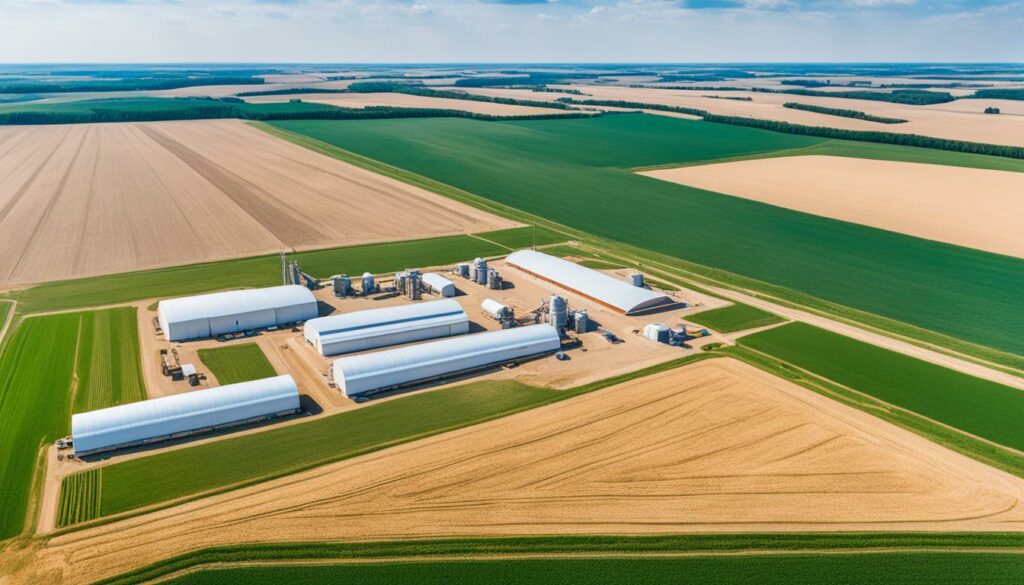
| Statistic | Details |
|---|---|
| Wartime grain shipment | 5.2 million metric tons (Feb 2024) |
| USDA export estimate increase | 7.3 million metric tons (Jan-Apr 2024) |
| Historic average monthly exports | 5.33 million metric tons (pre-invasion) |
| Decline in harvested areas (wheat, corn, barley) | 32%, 27%, 37% respectively (MY 2023/24) |
| Agriculture sector losses | $80 billion |
| Infrastructure damages | Over 160 facilities attacked |
| Grain destroyed in attacks | 300,000 tons |
| USAID investment | $350 million |
| Partner mobilised funds | $250 million |
| Increased export capacity | Estimated 2.5 million tons annually |
| New grain storage capacity | 1.5 million metric tons |
| Farmers receiving support | Over 30% |
Ukraine’s agriculture story is full of determination and adaptability. Since the Russian invasion, the country has faced $80 billion in losses. Of these, $35 billion came from crop production losses. Yet, Ukrainian farmers have not given up.
Sowing costs went up by 45-50% in 2023. But groups like AGRO helped farmers tackle these issues. AGRO gave 14,000 metric tonnes of fertiliser to 7,621 farmers between November 2023 and January 2024. What’s more, 28% of these farmers were women.
AGRO also helped farmers grow 278,000 more metric tonnes of grain in 2023-2024. This extra output earned over $127.8 million. It shows how Ukraine’s farming strength matters globally.
In December 2023, Ukraine’s exports included 43% maize and 26% wheat. AGRO aims to help store and process 300,000 tonnes of grain at once. This is to be done by around 990 small to medium-sized grain producers.
| Month | Total Agricultural Products Exported (tons) | Percentage Breakdown |
|---|---|---|
| March 2023 (First half) | 3.8 million |
|
With help from groups like AGRO, Ukrainian farmers produced more grain. Their hard work shows the power of Ukraine’s agricultural sector. It remains a key player in the world’s food supply chain.
The Black Sea Grain Initiative’s end made Ukraine act fast, leading to the making of the Ukrainian corridor. This corridor helped keep the grain exports going, though at lower levels than before. It’s been key in making sure the grains keep flowing during these tough times.
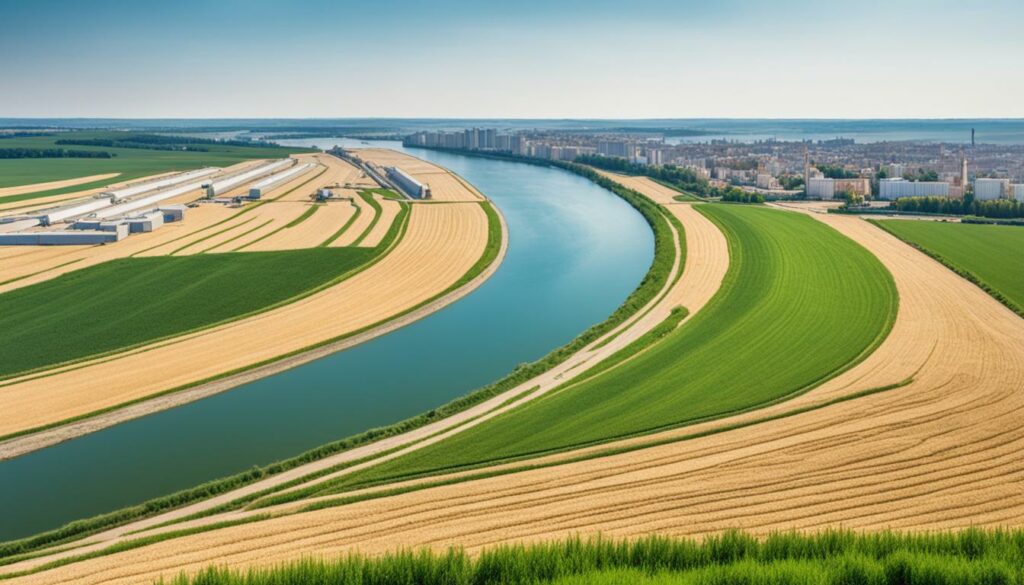
The Ukrainian corridor became crucial once the Black Sea Grain Initiative stopped. It uses ports in Greater Odesa and helped ship a record 5.2 million metric tons in one month. This new route shows Ukraine’s ability to change and overcome conflict’s effects on its agriculture.
The European Union’s creation of “solidarity lanes” has also been a big help. These lanes help Ukrainian food get to places worldwide, avoiding blocked sea routes.
Even with the war, Ukraine has kept up its export volumes. The USDA upped its export estimates for the MY 2023/24 by 7.3 million metric tons. Between January and April 2024, they sent out 63.77 million metric tons. This is a bit less than before but shows the corridor’s big role.
In January, Ukraine sent out 7.3 million tonnes of food, 60% by sea, which matches March 2023 levels. Over 700 ships have used Ukrainian sea routes since wheat harvesting began in August. This proves Ukraine’s sector is strong and well-planned.
The strategy is changing focus, moving from wheat to more oilseeds. The IGC expects this to continue into 2025. These shifts follow global needs and current farming issues.
| Year | Total Exports (Million Metric Tons) |
|---|---|
| 2018/19 | 67.52 |
| 2019/20 | 74.09 |
| 2023/24 (Estimated) | 63.77 |
Given all the challenges, Ukraine’s export achievements are remarkable. Even though exports are fewer than before the war, Ukraine’s determination to keep exporting grain is impressive. It shows how adaptable and resilient its agricultural sector is.
Recently, women have shown amazing strength and leadership in Ukraine’s farms. Even though the farming work is mostly done by men, the push for gender equality in agriculture is strong. Only 20 percent of farms in Ukraine are run by women. But their work is crucial, especially in hands-on farming.
Efforts to empower women in farming have made a big difference. These projects help with training and resources. They also encourage women to lead. Thanks to partnerships with groups like USAID, these steps have really helped rural areas in Ukraine grow. For example, the AGRI-Ukraine programme spent $350 million in the first year. It helped over 12,800 farmers with things like seeds and fertilisers.
Also, USAID and Corteva, Inc. are joining forces to support Ukrainian farmers. They focus on helping women who work with planting and harvesting. This is important because many women work as migrants in rural areas. In fact, 58 percent of migrant farm workers are women.
The journey to real gender equality in farming is tough. But ongoing help and new approaches are making a difference. They are changing farming in Ukraine for the better. As the sector grows stronger after facing war challenges, these steps are key. They aim to make farming in the country more open and effective.
The strength and drive of Ukraine’s small-scale farms shine through in the stories of local farmers. These tales show the ups and downs of farming in a small way. They also point out how important these farms are for the country’s economy.
Yuliia and Oleksandr are local heroes in the world of small scale agriculture in Ukraine. Even though the conflict created big problems, they never gave up. They used new farming methods and help from outside to beat the odds.
The support from the Ukrainian government and specific policies was a big help. These policies aim to keep farms going strong and help them grow. Yuliia and Oleksandr’s success proves that micro farming can be very successful despite tough times.

Tetyana Vovchenko’s story is all about not giving up and being creative in small scale agriculture Ukraine. Her farm faced many challenges, like higher cost and problems with delivery. But she kept going with the help of government and others.
With some help in 2023-2024, her farm made more grain. This helped bring in over $127.8 million with a little extra support. The Ukrainian government also made it easier for small farms to sell abroad. This was another big plus for her.
Stories like Yuliia and Oleksandr’s and Tetyana’s show us how important small farms are. They are vital for Ukraine’s farming and economy. Their hard work gives hope for the country’s future growth.
| Farmer | Achievements | Support Received | Outcome |
|---|---|---|---|
| Yuliia and Oleksandr | Enhanced farming activities | Modern techniques, government support | Successful adaptation and economic contribution |
| Tetyana Vovchenko | Increased grain production | AGRO fertilisers, international aid | Revenue generation, resilience in farming |
Innovations in grain farming have changed Ukraine’s economy, even during tough times. The economic contribution agriculture is strong because of new techniques and smarter ways of working. Ukraine leads globally in crops like sunflowers and corn, exporting lots of oil and corn.
Between 2018 and 2020, Russia and Ukraine sent out lots of wheat and corn. They shipped these grains to many countries. Big buyers were Egypt and China, showing the global effect of farming innovations.
The cost of grains went up in early 2021 due to war and other issues. This made cereal and oil more expensive. This shows the need for new farming practices to keep food markets steady.
USDA says Russian wheat sales might fall because of sanctions. Yet, there won’t likely be a wheat shortage worldwide, thanks to Ukraine and others. Even facing challenges, the grain farming industry stays strong.
Farming innovations protect against war issues and help grow in the long run. Although Ukraine’s economy shrank by 29% in 2022, farming’s impact is visible. It shows the industry can keep moving and recover.
| Country | Export Percentage |
|---|---|
| Egypt | 19% (Russian Wheat) |
| China | 16% (Ukrainian Corn) |
| India | 27% (Ukrainian Sunflower Oil) |
| MENA Region | 40% (Russian Wheat) |
Ukraine’s grain farming sector has shown amazing strength in tough times. In February 2024, it hit a record by shipping 5.2 million tons of grains. This shows how strong Ukrainian agriculture is, despite the hard times from wars and other problems.
The USDA has increased its estimates for Ukraine’s grain and oilseed exports. They’re expected to be 7.3 million tons more this year. Even though there’s been a drop in the area where these crops are grown, Ukraine’s farmers are still doing well. This shows that farming is very important for Ukraine’s economy.
Fifty-five percent of Ukraine’s land is good for farming. And farming provides jobs for 14% of the people there. It’s a major part of what Ukraine sells to the world. In 2021, the country made $27.8 billion from selling agricultural products. This was 41% of all the things Ukraine sold. Sunflower seeds are a big part of what Ukraine sells and it’s number one in the world for this.
But, farming in Ukraine has suffered a lot in the recent wars. The Kyiv School of Economics says it’s lost around $80 billion because of the fighting. Ukraine needs help from its government and other countries to recover. By using new farming methods and technology, Ukraine can make a strong comeback in farming. The future of farming in Ukraine looks good, with a focus on building back with smart and modern ways.
Ukrainian farmers are turning to modern tools and drones. They aim to grow more efficiently and produce more. These steps are key as they deal with difficulties from war and meet global demands.
Grain farming is vital to Ukraine’s economy. It has long been Europe’s ‘breadbasket’. The country’s rich soils play a big role in feeding the world and boosting its own economy.
The war has hit farming hard. It has damaged infrastructure and cut the available land. There have been problems with moving goods and trading. To recover, farmers need smart plans and investments.
The war blocked important routes to Black Sea ports. This reduced the land suitable for key crops by 32%. As a result, there’s been a drop in what Ukraine can produce and sell.
Farmers are turning to methods that are good for the environment. They’re also making more use of data and precision farming methods. These steps help them grow more food and use fewer resources, which is very important now.
The government is helping farmers with trade and money. They’re encouraging the use of new farming methods. These moves are important for keeping the farming sector strong during hard times.
Groups like USAID have given important help, like fertilisers. This aid has been a big help to many farms, especially small ones. It’s allowed them to keep going despite the war.
Modern machines and drones are making farming better in Ukraine. They’re letting farmers improve their operations. This means they can stay competitive even in tough times.
Yes, many farmers have shown how tough and smart they are during the war. People like Yuliia and Oleksandr, and Tetyana Vovchenko stand out. They’ve done well despite the challenges, showing the sector’s strength.
The farm’s future is in being green and smart. Ukraine wants to use both new tech and friendly practices. This way, they can grow strong again, feeding the country and the world.
By using new ways to farm and working hard, they’ve kept going. This resilience shows in their production and its impact on food security worldwide, even in the hardest times.
After the BSGI stopped, a new export route was created. It’s not yet as good as before the war, but it’s a sign of the sector’s ability to change and keep going.
More and more women are leading in farming. They’re being supported to grow their farms. This helps farming move forward and makes it more equal.
Yes, farmers like Yuliia, Oleksandr, and Tetyana Vovchenko have shown what small farms can do. Their stories tell of hard work and smart choices that lead to success, even in difficult times.
Innovations in farming are boosting Ukraine’s economy, even during the war. They’re helping meet local and global needs. This push for new ideas keeps the farming sector growing.